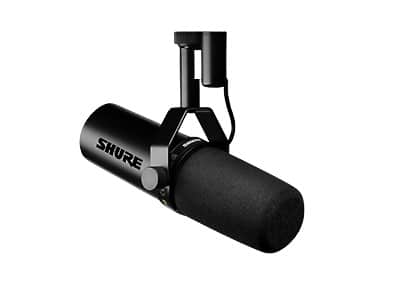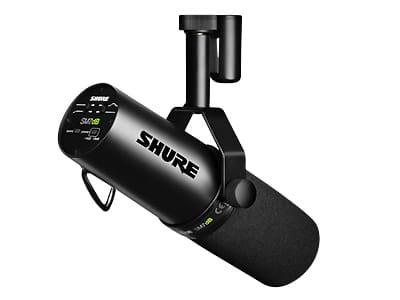Shure SM7dB: A Sonic Symphony of Luxury and Flawless Sound
Embark on an auditory journey with the Shure SM7dB, an exquisite addition to the renowned SM7 series and the epitome of podcast microphones. Widely acknowledged as the gold standard, the Shure SM7 series has left an indelible mark in studios across the globe. The Shure SM7dB takes this legacy further by introducing a built-in preamp, ensuring a luxurious and flawless sound experience every time, without any hassle.

Before delving into the intricacies, immerse yourself in the sonic wonders of the Shure SM7dB. To truly grasp its capabilities, tune in to the latest episode of the PetaPixel Podcast, where the microphone effortlessly captures my voice. Compare this experience with USB alternatives like those from Sennheiser and Sony . For a historical perspective, explore previous episodes featuring the Rode NT-USB+. Additionally, a quick sample recorded on the SM7dB provides a glimpse into its magic.
Unlike typical podcast microphones, the Shure SM7dB is not confined to the ordinary. Its recording prowess is unadulterated, unencumbered by the need for extensive post-production compression. Even in its raw form, the audio clip showcases the microphone's exceptional quality, with compression set to "heavy" using the Shure Motiv app. Further details on the Motiv app and using the mic with a USB connection will be explored below.
Shure SM7dB: Design and Build Quality

The Shure SM7 series is synonymous with robustness, and the SM7dB maintains this tradition. A substantial, yet elegant microphone, it is crafted for stationary studio use, eliminating the need for constant handling. The design is intuitive, featuring a capsule on one end and controls on the other, allowing customization of sound characteristics such as response, bass rolloff, and presence boost. The microphone is affixed to a collar that facilitates rotation and tilt for optimal positioning on a boom or microphone arm. Each component exudes high quality, ensuring durability and reliability.
What’s a Preamp and Why Does it Matter?

Central to the SM7dB's excellence is the inclusion of a built-in preamp, a distinguishing feature absent in the original SM7 series. But why is a preamp crucial? A preamplifier, or preamp, serves as an electronic amplifier converting a microphone's electrical signal into a robust output, resistant to noise and ready for further processing. While a preamp won't miraculously transform a mediocre microphone into a stellar one, it is indispensable for extracting high-quality audio from top-tier microphones.
Previous Shure SM7 microphones necessitated connection to an external preamp, a norm in high-end music and podcasting studios. The SM7B's sensitivity rating of -59 dB demands more gain than entry-level or mid-tier preamps can deliver. For podcasters recording in less professional settings like offices, the hassle of dealing with external preamps is unwelcome. USB microphones, such as the Rode NT-USB+, come equipped with built-in preamps, offering plug-and-play simplicity. The SM7dB bridges this gap, providing the same convenience and efficiency, simplifying audio workflows and making Shure's excellence more accessible.
Shure SM7dB: In Use
Diverging from the conventional broad-side capsule design, the Shure SM7dB adopts a shotgun microphone design, requiring direct addressing. Plosives, those intrusive bursts of sound accompanying words with 'p's, are masterfully controlled by the included sock, eliminating the need for an external pop filter. Shure's instructions recommend positioning the microphone between one and six inches from the mouth for optimal quality, a standard practice for podcasting mics. However, the substantial size of the microphone, in exchange for its fantastic quality, might impact visual aesthetics, making it less suitable for inconspicuous recording.
For users operating in high-end professional studios, a crucial addition to the setup is the Shure MVX2U Digital Audio Interface. Connecting to the XLR input of the SM7dB, this small yet pivotal plug transforms it into USB-C while providing phantom power. This component caters to those lacking an XLR interface, ensuring compatibility with computer-based podcasting setups. The SM7dB, being Shure's preamp-equipped version, eliminates the need for an external preamp or boost amplifier. While it incurs a premium, it proves cost-effective compared to assembling the components needed for the revered SM7B.
Shure’s Motiv App
While not obligatory, Shure offers the Motiv app, enhancing the capabilities of the SM7dB when connected to a computer using the MVX2U adapter. Despite mixed reviews, my experience with the Motiv app was seamless. The manual controls are effective, with noticeable distinctions when adjusting the compressor between "heavy" and "light." Although I still run post-processing on the audio, the built-in features, including the limiter, add value to the overall recording experience.
The Motiv app extends customization options, allowing users to tweak EQ settings and apply a high-pass filter. Notably, it facilitates fine-tuning of the monitor mix, compensating for the absence of a physical dial on the SM7dB. While not a necessity, the Motiv app enhances user control and adds versatility to the microphone's capabilities.
Shure SM7dB: Luxurious Sound
For those seeking a microphone capable of faithfully capturing the nuances of their voice, the Shure SM7dB stands as an unequivocal choice. To harness its full potential for computer use, additional components are required, with Shure's Motiv software and the MVX2U adapter forming an ideal synergy. However, this investment signifies a commitment to a microphone that transcends ordinary standards. The absence of a discussion on boom arms highlights the multifaceted nature of the SM7dB's capabilities, delving into its core excellence before branching into accessory considerations.
Compared to popular plug-and-play USB microphones, the Shure SM7dB emerges as a superior contender. Its vocals exhibit a broader range, particularly in the low frequencies, attesting to Shure's reputable sound engineering. The premium price tag aligns with the expectation of exceptional audio quality, reaffirming Shure's standing in the industry.
Are There Alternatives?
While the Shure SM7dB represents the pinnacle of audio excellence, alternatives exist for those with budget constraints or different preferences. Cheaper microphones like the Sennheiser Profile or the Rode NT-USB+ offer respectable performance, especially in handling low frequencies. While they might not match the expansive range of the SM7dB, they serve as solid alternatives for those not ready to make the leap to an XLR microphone.
Sony's ECM-S1, albeit expensive for a USB microphone, caters to a niche market with its seamless integration with Alpha series cameras and the inclusion of a wireless receiver. However, in a direct comparison, the Sony microphone falls short in sound quality when pitted against competitors like Rode, Sennheiser, and especially Shure.
In conclusion, the Shure SM7dB transcends the realm of microphones, offering a luxurious and unparalleled sound experience. Its integration of a built-in preamp, distinctive design, and compatibility enhancements through the Motiv app and MVX2U adapter solidify its position as a premium choice. While alternatives exist, the SM7dB's exceptional audio quality justifies its investment, making it a coveted asset
To view more products Click Here

Comments
Post a Comment